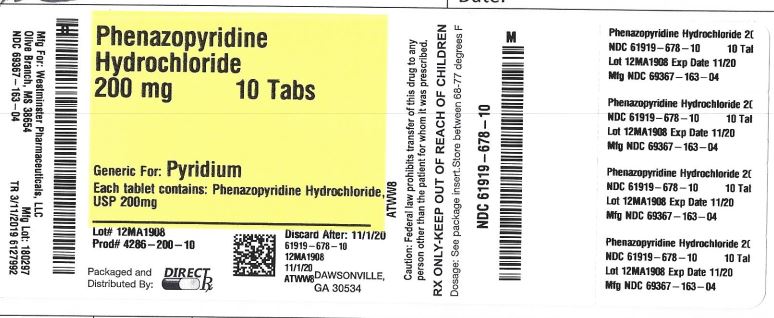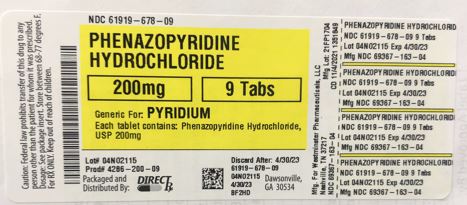Phenazopyridine Hydrochloride is light or dark red to dark violet, odorless, slightly bitter, crystalline powder. It has a specific local analgesic effect in the urinary tract, promptly relieving burning and pain. It has the following structural formula.
Chemical Structure
Inactive Ingredients: Corn Starch, Croscarmellose Sodium, Hypromellose, Magnesium Stearate, Microcrystalline Cellulose, Mineral Oil, Povidone, Pregelatinized Starch, Propylene Glycol and Silicon Dioxide.
Phenazopyridine HCl is excreted in the urine where it exerts a topical analgesic effect on the mucosa of the urinary tract. This action helps to relieve pain, burning, urgency and frequency. The precise mechanism of action is not known.
The pharmacokinetic properties of Phenazopyridine HCl have not been determined. Phenazopyridine HCl is rapidly excreted by the kidneys, with as much as 66% of an oral dose being excreted unchanged in the urine.
Phenazopyridine HCl is indicated for the symptomatic relief of pain, burning, urgency, frequency, and other discomforts arising from irritation of the lower urinary tract mucosa caused by infection, trauma, surgery, endoscopic procedures, or the passage of sounds or catheters. The use of Phenazopyridine HCl for relief of symptoms should not delay definitive diagnosis and treatment of causative conditions. Because it provides only symptomatic relief, prompt appropriate treatment of the cause of pain must be instituted and Phenazopyridine HCl should be discontinued when symptoms are controlled.
The analgesic action may reduce or eliminate the need for systemic analgesics or narcotics. It is, however, compatible with antibacterial therapy and can help to relieve pain and discomfort during the interval before antibacterial therapy controls the infection. Treatment of a urinary tract infection with Phenazopyridine HCl should not exceed 2 days because there is a lack of evidence that the combined administration of Phenazopyridine HCl and an antibacterial provides greater benefit than administration of the antibacterial alone after 2 days. (See DOSAGE AND ADMINISTRATION section).
Phenazopyridine HCl should not be used in patients who have previously exhibited hypersensitivity to It. The use of Phenazopyridine HCl is contraindicated in patients with renal insufficiency.
Headache, rash, pruritus and occasional gastrointestinal disturbance. An anaphylactoid like reaction has been described. Methemoglobinemia, hemolytic anemia, renal and hepatic toxicity have been reported, usually at overdosage levels (see OVERDOSAGE Section).
General
A yellowish tinge of the skin or sclera may indicate accumulation due to impaired renal excretion and the need to discontinue therapy. The decline in renal function associated with advanced age should be kept in mind.
NOTE : Patients should be informed that Phenazopyridine HCl produces a reddish-orange discoloration of the urine and may stain fabric. Staining of contact lenses has been reported.
Laboratory Test Interaction
Due to its properties as an azo dye, Phenazopyridine HCl may interfere with urinalysis based on spectrometry or color reactions.
Carcinogenesis, Mutagenesis, Impairment of Fertility
Long-term administration of Phenazopyridine HCl has induced neoplasia in rats (large intestine) and mice (liver). Although no association between Phenazopyridine HCl and human neoplasia has been reported, adequate epidemiological studies along these lines have not been conducted.
Pregnancy Category B
Reproduction studies have been performed in rats at doses up to 50 mg/Kg/day and have revealed no evidence of impaired fertility or harm to the fetus due to Phenazopyridine HCl. There are, however, no adequate and well controlled studies pregnant women. Because animal production studies are not always predictive of human response, this drug should be used during pregnancy only if clearly needed.
Nursing mothers
No information is available on the appearance of Phenazopyridine HCl, or its metabolites in human milk.
100 mg Tablets: Average adult dosage is two tablets 3 times a day after meals.
200 mg Tablets: Average adult dosage is one tablet 3 times a day after meals.
When used concomitantly with an antibacterial agent for the treatment of a urinary tract infection, the administration of Phenazopyridine HCl should not exceed 2 days.
Exceeding the recommended dose in patients with good renal function or administering the usual dose to patients with impaired renal function (common in elderly patients) may lead to increased serum levels and toxic reactions. Methemoglobinemia generally follows a massive, acute overdose. Methylene blue, 1 to 2 mg/kg/body weight intravenously or ascorbic acid 100 to 200 mg given orally should cause prompt reduction of the methemoglobinemia and disappearance of the cyanosis which is an aid in diagnosis. Oxidative Heinz body hemolytic anemia may also occur, and "bite cells" (degmacytes) may be present in a chronic overdosage situation. Red blood cell G-6-PD deficiency may predispose to hemolysis. Renal and hepatic impairment and occasional failure, usually due to hypersensitivity, may also occur.
Phenazopyridine Hydrochloride – Westminster Pharmaceuticals, LLC
Prescription Medications
Phenazopyridine Hydrochloride, USP
PHENAZOPYRIDINE HYDROCHLORIDE Phenazopyridine hydrochloride tablet
Westminster Pharmaceuticals LLC.
Disclaimer: This drug has not been found by FDA to be safe and effective, and this labeling has not been approved by FDA. Label 100 mg, Label 200 mg
Rx Only
Phenazopyridine hydrochloride is reasonably anticipated to be a human carcinogen based on sufficient evidence of carcinogenicity in experimental animals (IARC 1980, 1982, 1987, NCI 1978). When administered in the diet, Phenazopyridine hydrochloride increased the incidences of hepatocellular adenomas and carcinomas in female mice and adenomas and adenocarcinomas of the colon and rectum in rats of both sexes. There is inadequate evidence for the carcinogenicity of Phenazopyridine hydrochloride in humans (TARC 1987). In one limited epidemiological study, no significant excess of any cancer was observed among 2,214 patients who received Phenazopyridine hydrochloride and were followed for a minimum of 3 years.
Manufactured for:
Westminster Pharmaceuticals, LLC
154 Downing Street, Unit 1 & 2
Olive Branch, MS 38654
Rev: 10/18
100 mg Tablets: Supplied in bottles of
Appearance: Reddish-brown, round, film coated tablets, debossed "701" on one side and plain on other side.
200 mg Tablets: Supplied in bottles of
Appearance: Reddish-brown, round, film coated tablets, debossed "813" on one side and plain on other side.
DISPENSE contents with a child-resistant closure (as required) and in a tight container as defined in the USP.
STORE at 20° -25°C (68°-77°F) with excursions permitted between 15°-30°C (59°-86°F) [see USP controlled Room Temperature].


